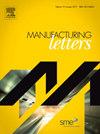同时4D打印和原位发泡定制聚乳酸泡沫的形状记忆行为
IF 2
Q3 ENGINEERING, MANUFACTURING
引用次数: 0
摘要
本研究介绍了一种创新的4D打印技术,结合原位发泡,以提高聚乳酸(PLA)泡沫的形状记忆性能。通过将PLA与偶氮二甲酰胺(AZO)在其分解温度以下熔融混合,然后直接进行颗粒打印,获得了均匀的微孔结构和定制的形状记忆行为。研究结果表明,较高的AZO含量提高了形状固定性(~ 96%),但降低了形状恢复。此外,编程温度对性能有显著影响,热编程提高了形状的固结性,冷编程提高了形状的恢复性。这种新颖的方法为具有可编程特性的轻质、隔热和减震材料提供了潜在的应用。本文章由计算机程序翻译,如有差异,请以英文原文为准。
Simultaneous 4D printing and In-Situ foaming for tailoring shape memory behaviors in polylactic acid foams
This study introduces an innovative 4D printing technique combined with in-situ foaming to enhance the shape memory properties of polylactic acid (PLA) foams. By melt mixing PLA with azodicarbonamide (AZO) below its decomposition temperature, followed by direct pellet printing, the research achieves uniform microporous structures and tailored shape memory behaviors. The findings demonstrate that higher AZO content improves shape fixity (∼96 %) but reduces shape recovery. Moreover, the programming temperature significantly influences performance, with hot programming enhancing shape fixity and cold programming boosting shape recovery. This novel approach offers potential applications in lightweight, thermally insulative, and shock-absorbing materials with programmable properties.
求助全文
通过发布文献求助,成功后即可免费获取论文全文。
去求助
来源期刊

Manufacturing Letters
Engineering-Industrial and Manufacturing Engineering
CiteScore
4.20
自引率
5.10%
发文量
192
审稿时长
60 days
 求助内容:
求助内容: 应助结果提醒方式:
应助结果提醒方式:


